MRRL Hall of Fame
STEVE HUNTER
- Details
- Category: Inductees
- Created: Thursday, 04 June 2015 03:03
- Written by Gary Johnson
Guitar virtuoso Steve Hunter was the first instrumentalist to be voted into the MRRL online Hall of Fame. He started his recording career with the band Detroit featuring Mitch Ryder but is probably best-known for his contributions to the music of Lou Reed and Alice Cooper. Over the years, Hunter has been featured either on record or on stage, or both, with other notable artists including Aerosmith, David Lee Roth, Tracy Chapman, Glen Campbell, Bette Midler, Julian Lennon, Jack Bruce, and Dr. John. In addition, Hunter has recorded six solo albums, the most recent being “Tone Poems Live” in 2014.
Steve Hunter was born in Decatur, Illinois in 1948. He remembers it as a great place to grow up, an area made up primarily of farmland and featuring simple, small town living. Steve was introduced to music through his father, Selby Hunter. Selby played guitar when he was in the Army and kept at it after he was discharged, got married, and had children. Although his work in the shipping department at a local pharmaceutical company and family obligations limited his time on the instrument, Steve remembers at the age of 3 being fascinated by the sound of his father’s guitar. 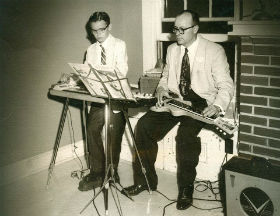 Steve, at 10, with father Selby Hunter
Steve, at 10, with father Selby Hunter
When Steve was 5 or 6 years old a group of what the folks in Decatur referred to as “suit people” came to his school and gave aptitude tests to the students. Steve tested high for music and when he got a little older; his father asked him if he wanted to play an instrument. Since Selby also owned a lap steel guitar, Steve started taking lessons on the lap steel at the age of 8 and continued on the instrument for the next five years.
Selby Hunter was a big fan of the country music recording artists of the 40s, 50s, and 60s including Hank Williams, Webb Pierce, and Tex Ritter to name just a few. The lap steel was a signature sound on these early records and no musician was more in demand as a lap steel session player than Jerry Byrd. Steve got to see him play in person when he was a 10-year-old. His father drove him to Sandusky, Ohio to participate in a large instrumental talent contest for young people under the age of eighteen; and Jerry Byrd was playing in a small room at the hotel they were staying. Steve watched him in awe and still recalls the experience: “He was the Eddie Van Halen of the lap steel.”
Steve Hunter is also probably one of the few rock guitarists to mention the Lawrence Welk Show as an influence. His grandfather on his mother’s side, John Henry Gates, was a big fan of the television program and Steve and his family would often go over to his grandfather’s house of Saturdays. Steve and his grandfather, a retired railroad worker, had a great relationship. They used to sit together and watch Lawrence Welk on a small black and white TV complete with a rabbit-ear antenna. Welk’s guitarists, Buddy Merrill and Neil LeVang, were big inspirations to Steve; and his grandfather used to tell him that he could be good enough to play on that show one day. 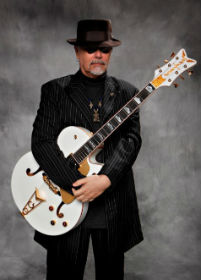 Steve Hunter
Steve Hunter
The first rock and roll record that really got his attention was “Sleep Walk” by Santo & Johnny because it featured a lap steel guitar. The song was a # 1 hit for Brooklyn-born brothers Santo and Johnny Farina in 1959. Featuring Santo Farina on lap steel, the guitar duo had another Top 40 hit with “Tear Drop” later that same year.
Steve was inspired to start playing a regular guitar after hearing Chet Atkins. The Ventures and Duane Eddy were also early favorites, and he watched them perform after school on American Bandstand, which was broadcast five days a week in the early 1960s.
By 1964 he became turned on by The Beatles and The Rolling Stones. The electric guitar had an all new meaning as he started to appreciate both the power and expressiveness of the instrument. Steve played in his first band, The Weejuns, when he was in high school. Formed to play at a dance at school, their unusual band name came from a popular penny loafer produced by the Bass shoe company. Like almost all young bands in the 60s, they covered popular songs of the day like “Louie, Louie” and “Land Of A Thousand Dances”.
Steve was originally interested in the blues because he thought it was an easy type of music to play. He was inspired by guitarist Michael Bloomfield and bands like Cream that were playing what was termed “electric blues”. Although it was a simple form of music to get started on, he soon discovered that the genre was very complex and ever evolving. He loved the expressiveness of the blues and found that it was a type of music that required a great deal of feeling. When he read interviews with the new breed of blues-based guitarists like Bloomfield, Jimmy Page, Eric Clapton, or Jimi Hendrix, they mentioned B. B. King and Albert King – artists that Hunter had not yet heard of. After discovering the original blues masters, Steve bought their records and began to discover the roots of the music he loved. 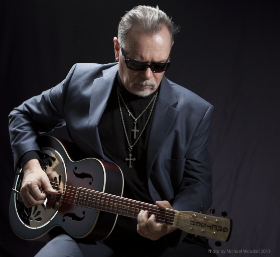 Steve "The Deacon" Hunter
Steve "The Deacon" Hunter
Hunter graduated from Decatur's MacArthur High School in 1966. Although he was a good student, he was fed up with studying by his senior year. Since his father wasn’t making a great deal of money to help pay for tuition and books, college was not on his agenda.
His next band, John Paul and The Jones Boys, was formed after graduation. The group was fashioned somewhat after Paul Revere & the Raiders, and Steve’s mother sewed the band uniforms. John Paul and The Jones Boys played mostly covers but also featured some original material composed by the band members.
Like all young men in the late 1960s he faced the draft and possible deployment overseas. Hunter was not adverse to serving since he figured that he would not see combat in Vietnam because he wore glasses and suffered from relatively poor vision. Also, as a veteran, he would be able to use the G.I. Bill to attend college after his discharge if he chose to pursue it.
Following his induction into the Army, Hunter was sent to x-ray school and became an x-ray tech. After completing his training, he was stationed in a hospital for wounded soldiers in Okinawa, Japan. The duty was difficult as he had to go into the wards to work with servicemen who had been severely wounded in Vietnam; and he witnessed firsthand the terrible wounds and suffering that came with combat. 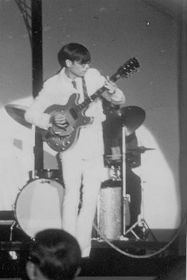 1969 Hunter at military talent show
1969 Hunter at military talent show
While Steve was stationed in Okinawa, he continued to play guitar and won an all-military talent contest. It was an event that he believes was a turning point in his musical career. Hunter described it as a rather bizarre experience in that all the ambulatory patients from the hospital were brought to the event. The first two or three rows of the audience were black soldiers who scoffed and booed when it was announced that Hunter, a white guitarist, was going to play the blues. Although he had a black drummer and a black bassist, none of the soldiers apparently believed that a white guy with glasses could play that style of music. At the end of their original 12-bar blues tune, however, all of the black soldiers were cheering. The change blew Hunter away and, by the time he walked offstage, he knew what he wanted to do for a living.
After he was discharged from the Army in 1970, Hunter had a somewhat difficult time re-adjusting to civilian life. Like so many veterans, his time overseas had been an ordeal and he had been forced to grow up a lot as a result of his experiences. When he got home, it seemed that everything was different in Decatur and he felt out of place for several months.
The Light Brigade, was formed after he was discharged and the band helped him to get re-acclimated to civilian life. The band gigged in bars and night clubs, typically playing five sets per night with an opening set devoted to the songs of B. B. King. It was during that time that he decided it was time to get out of Decatur and get out into the world. Ironically, that was when John Sauter called him about auditioning for a new band named Detroit that featured Mitch Ryder as the lead singer.
Sauter was from Decatur. Although Hunter had never been in a band with him, Hunter had heard Sauter playing bass in other area groups. Since the two of them played on the same circuit of bars and clubs, they had become friends.
Steve, like so many others in his age group, had been a fan of Mitch Ryder & The Detroit Wheels and their string of hits from 1965 thru 1967. He had covered “Devil With A Blue Dress On & Good Golly Miss Molly” while in the Light Brigade. 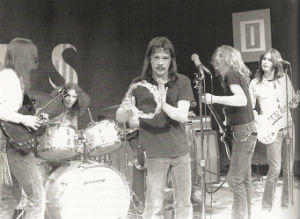 Detroit on stage: Steve Hunter, John Baddanjek, Mitch Ryder, Ron Cooke, Brett Tuggle
Detroit on stage: Steve Hunter, John Baddanjek, Mitch Ryder, Ron Cooke, Brett Tuggle
Hunter joined Detroit in the fall of 1970, a few months after the band had played the Goose Lake International Music Festival. Detroit hadn’t started to record their album at that point but had recruited Bob Ezrin to produce their debut. Ezrin was a hot new Canadian music producer and keyboardist who had just put Alice Cooper on the map by producing their breakthrough album “Love It To Death” and its hit single “Eighteen”.
Steve and Bob Ezrin hit it off immediately. Hunter says that he was always blown away by Ezrin’s ability to hear the record finished before they even started. In other words, once he heard the songs, Ezrin had the uncanny ability to hear the finished product in his mind. Hunter pointed out that Ezrin was always flexible during the recording process, however, and also had an unique talent for getting a top performance out of everybody in the studio. 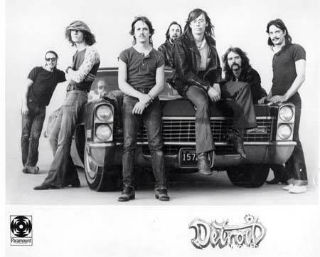 Hunter seated on hood of car
Hunter seated on hood of car
Despite having Ezrin at the helm in the studio, there was some turmoil in the band. Rampant drug use and sexual debauchery were apparently the order of the day for some of Detroit’s band members and road crew. Their undisciplined behavior was the reason keyboardist Boot Hamilton and bassist John Sauter quit Detroit in the midst of recording their album. Hunter was new in the band and was basically out of the loop as to the reasons why Hamilton and Sauter left after recording just four songs. 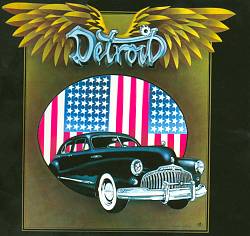 The "Detroit" album
The "Detroit" album
The album’s key song was a cover of Lou Reed’s “Rock ‘N Roll”, first recorded on the “Loaded” album while he was a member of the Velvet Underground. Ryder wanted to record the song and brought it to one of the sessions.
Hunter had just seen Leslie West’s band, Mountain, at the Eastown Theatre in downtown Detroit and he was blown away by West’s guitar playing. When Detroit recorded the song, Hunter approached the arrangement the way he thought Leslie West would play it. Years later, West told Hunter that people used to ask him about “Rock ‘N Roll”, thinking that it was Mountain that had recorded it because the guitar style was so similar.
“Rock ‘N Roll” was released as a single and received a great deal of airplay in Michigan. Even though it literally jumped off the radio in early 1972, it only reached #107 nationally on the Billboard chart. Hunter felt that the record should have been a much bigger hit but failed because of Paramount Records. The label didn’t do a very good job of promoting the self-titled “Detroit” album despite the fact that the band was working very hard and touring all over the country to support it. In the end, Paramount’s unwillingness to adequately back the band was the main reason for the demise of Detroit. In 2015, Rolling Stone magazine published a list titled 20 Rock Albums Rolling Stone Loved in the 1970s That You Never Heard. Detroit’s album was on the list.
Following the break-up of Detroit, Hunter’s next stop was working on Lou Reed’s album “Berlin”. Reed had heard Detroit’s version of “Rock “N Roll” on a Long Island radio station and told Bob Ezrin, "Berlin's" producer, that it was the way he always wanted the song to sound. Reed asked Ezrin to get the guitarist from Detroit to play on “Berlin” and, the next thing Hunter knew, he was booked on a flight to London to work on Reed’s new album.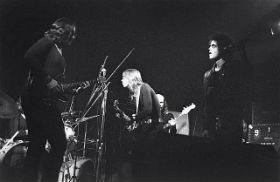 1973 Tour: Dick Wagner, Hunter, and Lou Reed Lou Reed
1973 Tour: Dick Wagner, Hunter, and Lou Reed Lou Reed
After “Berlin” was completed, Lou Reed was scheduled to go on tour to support the album. Bob Ezrin called Dick Wagner to put together a band and they recruited Steve Hunter as a second guitarist. Hunter had first met Dick Wagner while he was doing a a brief tour with the Chambers Brothers. Steve and Joe Chambers went to see Wagner and his new band, Ursa Major, at a gig in a club in Florida called The Flying Machine.
Hunter and Wagner had an interesting guitar relationship. Hunter felt that the connection came from the fact that they had slightly different styles and that they tended to think almost the opposite of each other. Strangely enough, when it came time to play together, Hunter said that they rarely ever had to work anything out beyond the melody lines of the songs, and that the rhythm parts came naturally. Hunter felt that the great musical interplay between them came about because they were so different as people. 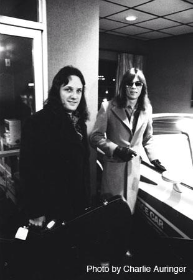 1975 Wagner and Hunter
1975 Wagner and Hunter
In his 2012 rock and roll memoir, Not Only Women Bleed, Dick Wagner wrote about the times the duo played together. “My years with Steve Hunter were the very epitome of what two rock guitarists could sound like. Steve was my hero and one of the best rock/blues guitarists in the business. I learned a lot from and with him. He made collaboration easy with his liquid style and transcendent sound.”
According to Wagner’s book, the subsequent Lou Reed tour was very successful and drew rave reviews in Europe. Much of the press praised the band and derided Reed for being seemingly out of touch. The Hunter/Wagner guitar duo was singled out as the highlight of the show on most occasions. In Reed’s defense, Wagner also wrote that Lou was going through a difficult personal time during the tour and was not completely on his game.
Hunter said that he had very little interaction with Lou Reed while on tour with him in the 70’s. Hunter was quiet and learning the ropes while Reed was busy doing interviews so they rarely spoke. When they returned to America their live show was recorded at The Brooklyn Academy of Music in New York. The first of these recordings were issued on the “Rock “N Roll Animal” album from 1974. It became Lou Reed’s first Gold Record in America, and it brought Steve Hunter to the attention of guitar aficionados worldwide. Steve wrote the brilliant instrumental intro to “Sweet Jane” that kicked off the LP, and his stellar guitar duets with Wagner were album highlights. In 2010, Gibson.com honored both Hunter and Wagner by selecting the three-and-a-half minute “Into To Sweet Jane” as # 25 among the Top 50
Guitar Solos of All Time. 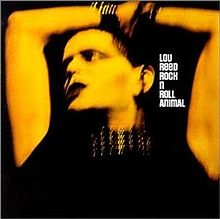 "Rock 'n' Roll Animal" LP
"Rock 'n' Roll Animal" LP
The attention generated by “Rock ‘N Roll Animal” was important for a musician not in a steady band. For Hunter to get session work; he had to rely on word getting around and, at that time, the best way to do it was to play on a hit album and work with a successful producer like Bob Ezrin. When he didn’t have a gig, Hunter would often return to his parents’ house in Decatur. For many of Hunter’s session dates in the 1970s, Ezrin would call him in Decatur and tell him where and when he needed to report.
Another of Steve Hunter’s memorable guitar sessions was for the Aerosmith LP “Get Your Wings”. Jack Douglas and Ray Colcord were co-producing the album with Ezrin serving as the executive producer. Hunter was sitting in the lobby of the Record Plant in New York smoking a cigarette while Ezrin was in Studio A editing an Alice Cooper album. Jack Douglas was working in Studio B on the Aerosmith LP and poked his head out the door and asked Hunter if he’d like to play on it. Hunter went in the studio and added the opening half solos to “Train Kept A Rollin’”. He was only there for an hour but the cut was the highlight of the “Get Your Wings” LP and eventually became Aerosmith’s signature, show-stopping song in concert.
Steve also played guitar on Jack Bruce’s fourth solo LP, “Out of the Storm”, in 1974. Engineer/producer Andy Johns felt that that problem with Bruce’s previous solo albums was that he worked with too many British musicians and that he needed to work with some great American session players who could complete an album in two weeks. Hunter along with drummers Jim Gordon and Jim Keltner were brought in and the album was recorded in Los Angeles and San Francisco. 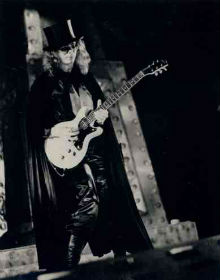 Steve Hunter
Steve Hunter
Hunter first worked with Alice Cooper on the band’s “Billion Dollar Babies” LP. Because guitarist Glen Buxton was suffering from a substance abuse problem, both Hunter and Dick Wagner were brought in to help cover for him. Steve played on six songs on the album, including the title track and the Top 40 single “Hello Hurray” on which he provided the lap steel solo. “Billion Dollar Babies” became Alice Cooper’s first # 1 album in 1973.
Steve’s next project with Alice Cooper was “Welcome To My Nightmare”. Hunter feels that his experience playing on the album and the subsequent world tour was the first time that he was in the big time. It was Cooper’s first solo album after the break-up of the original band, so both the LP and tour were very important. Hunter was once again teamed with Dick Wagner in the studio and on the elaborate tour; and Steve enjoyed the experience and the camaraderie of the project from start to finish.
The lengthy tour was specifically designed to introduce a more mainstream-friendly Alice Cooper persona to the masses, forgoing some of the gorier, edgier aspects of past live productions. It was a slick, almost cartoonish show that was produced, directed and choreographed by David Winters, who had previously choreographed films starring Elvis Presley and Ann-Margret. 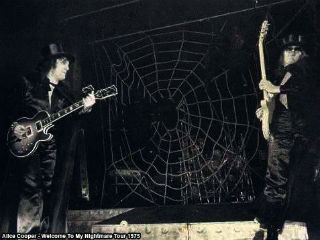 Wagner and Hunter - Welcome To My Nightmare Tour
Wagner and Hunter - Welcome To My Nightmare Tour
Framed as a nightmare experienced by a boy named Steven, the show included Alice Cooper classics like “No More Mr. Nice Guy,” “I’m Eighteen” and “School’s Out” along with songs from the new album played by a crack band anchored by the twin guitar attack of Steve Hunter and Dick Wagner. The show was staged as a slick multi-media production that featured filmed projections, four dancers, along with elaborate sets and costumes. In the course of the nightmare Cooper encountered dancing skeletons, a faceless demon, a nine-foot cyclops, and enormous spiders. Both Hunter and Wagner also appeared in the 1975 Welcome To My Nightmare TV special. 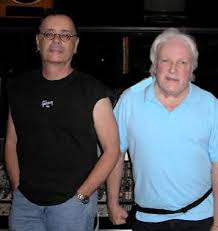 Steve Hunter & Dick Wagner
Steve Hunter & Dick Wagner
Hunter says that he and Wagner often talked about putting a band together. They would typically meet and go over some ideas but it just never seemed to come together. Hunter felt that the partnership worked great with Lou Reed and Alice Cooper because they were both concentrating on other peoples’ music. But when they attempted to do something with their own music, they couldn’t seem to find the right blend. Wagner’s songs included vocals and Hunter’s compositions were instrumentals; and they were never able to find a workable combination.
The last time they tried, Hunter flew up to Saginaw in the late 90s to write songs at Wagner’s studio but, once again, it didn’t work out. Hunter felt the reason went back to the two of them being opposites. Wagner writes his songs his way and so does Hunter and, as a result, they were once again unable to find common ground for a recording project.
Hunter played with Alice Cooper steadily from 1975 through 1979 but was involved with numerous other projects as well. In early 1977, he played on Peter Gabriel’s first solo album. The most important track on which Steve contributed guitar was the album’s lead single “Solsbury Hill”, an autobiographical song in which Gabriel expressed his thoughts about leaving Genesis. 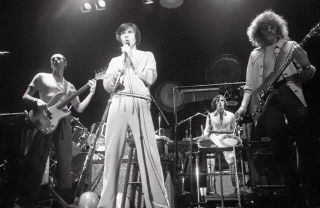 Hunter (right) on tour with Peter Gabriel
Hunter (right) on tour with Peter Gabriel
“Solsbury Hill” was Peter Gabriel’s first success as a solo artist in both England and the United States. Bob Ezrin was the producer and Robert Fripp of King Crimson fame also played guitar on the album.
Hunter recorded his first solo album, “Swept Away” on the ATCO label in 1977 with Ezrin producing. Steve claims didn’t have enough songs for the album but was not about to turn down the chance to record an LP of his own; so he was writing right up until the day he was scheduled to start recording. He ended up penning two songs about his hometown of Decatur. “Eldorado Street” was the main drag in town where he used to cruise on Saturday nights with friends in high school to get malts at the Steak and Shake and food at a burger joint called Sandy’s. “Jasper St. Viaduct Gitar Rag” was about a structure with an underground tunnel beneath a train trellis. It featured a nice echo and everyone in Decatur used to honk their car horns when driving through it. 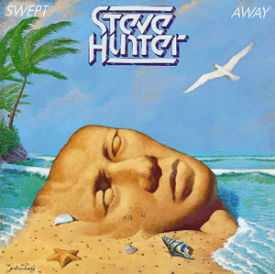 "Swept Away" album
"Swept Away" album
After his solo record was completed, Hunter was scheduled to go on the road with Peter Gabriel. His idea was to open for Gabriel playing his solo material and then have Gabriel come on and do his show with the band. The sticking point was drummer Allan Schwartzberg who felt he couldn’t do three hours per night.
Hunter recruited drummer Bruce Gary, who went on to fame with The Knack a few years later, and Patti Quatro, formerly of the Pleasure Seekers, to play guitar and sing a couple of songs. Gabriel was all for it, but Hunter needed about $10,000 to pay Gary and Quatro. Hunter's novel idea to promote his "Swept Away"album had to be dropped, however, when ATCO refused to put up the money.
Because of the general lack of interest in instrumental rock and roll albums in the 70s and 80s, it took ten years for Hunter to record his second one. It only happened because Miles Copeland had put together an instrumental label called No Speak Records. Hunter read about it in a newspaper in Los Angeles and called Copeland for an interview. Hunter was impressed with Copeland; he was very straight-up in telling Hunter what he was going to do and not going to do.
His second solo album’s title was “The Deacon” which is Steve’s nickname. He got it from Bob Ezrin after he had called Hunter to work on the Peter Gabriel album. They hadn’t seen each other for almost a year, and Ezrin kiddingly asked him if he had gotten into drugs and/or alcohol during that time. Hunter replied, “No. I’m still the deacon of rock and roll.” Ezrin thought his comment was hilarious, and after he began calling Steve ‘The Deacon’, the nickname stuck. 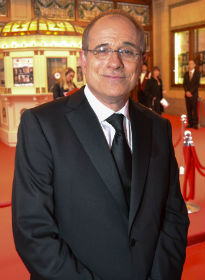 Bob Ezrin
Bob Ezrin
Hunter’s session work was varied. He collaborated with David Lee Roth on two of his solo albums. Steve co-wrote four songs with Roth for his 1991 release, “A Lil’ Ain’t Enough”. He also co-wrote one song on Roth’s next LP, “Your Filthy Little Mouth” in 1994, but never toured with the Van Halen front man.
He also worked with Julian Lennon in 1991 on his “Help Yourself” album produced by Bob Ezrin. Although it did not do well in the United States, the album was a commercial success in Europe for Lennon, spawning a U.K. # 6 single with “Saltwater”. Hunter supplied the slide solo on the hit single and played on several other songs on the album.
Additionally, Steve toured with Tracy Chapman for almost four years. He was originally called by her management to do just a short tour. The chemistry between them was great, however, and it gave him a chance to play a more quiet type of music not only on electric guitar but also on dulcimer, acoustic guitar, dobro, and mandolin.
Hunter played those same instruments on Chapman’s “Telling Stories” in 2000. It was the fifth album by the singer/songwriter and her first in over four years. Steve played electric guitar on Chapman’s 2002 album “Let It Rain”, which featured more of an alternative rock sound. 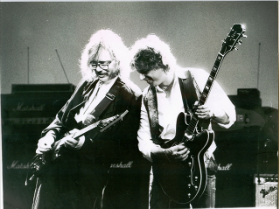 Steve Hunter and Pete Haycock
Steve Hunter and Pete Haycock
Steve met his wife Karen Ann Hunter through Pete Haycock, formerly of the Climax Blues Band. Haycock had joined Hunter on a tour of England along with Steve Howe, Leslie West, Robbie Krieger, and Randy California to support Miles Copeland’s No Speak label. Hunter and Haycock had not spoken for a time when they got back in touch and exchanged tracks they were working on. Haycock suggested a British girl singer he had been working with to write lyrics for one of Steve’s instrumental compositions.
Despite the fact that he later decided he preferred “Nylon Café” as an instrumental, Steve and Karen got together in 2004 with Haycock acting of something of a matchmaker. Karen had been in show business in England as a performer and recording artist, including tours with Gary Numan. 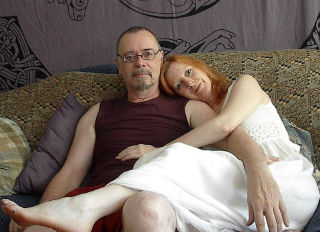 Steve and Karen Hunter
Steve and Karen Hunter
Karen and Steve married in 2007 and their partnership has been both very happy and very productive. Karen recorded her album, “Empty Spaces” in 2010 with Steve producing. In addition to her music career, Karen is an accomplished photographer and her new photo print collection, Cream of the Cropped, is now available from her Esty store. She is also a highly regarded artist and her newest passion involves using fabric as a collage medium.
Steve reunited with Lou Reed in 2006 to present a new live version of “Berlin”. The performance was released in 2008 as the DVD and CD “Berlin: Live at St. Ann’s Warehouse”. Besides Hunter, Reed was joined on stage by singers Sharon Jones and Antony Hegarty, pianist Rupert Christie, a horn and string section, and the Brooklyn Youth Chorus. The show was co-produced by Bob Ezrin. Steve noted that Reed was much more open than he was back in the 1970s, and he acted if he and Hunter were brothers. 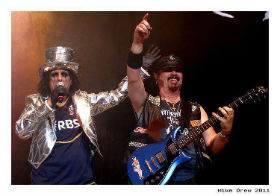 Alice Cooper and Hunter 2011
Alice Cooper and Hunter 2011
Hunter had not worked with Alice Cooper for over 30 years when played on the “Welcome 2 My Nightmare” sequel album and then did a seven-month tour in 2011. Steve said it was one of the hardest tours he ever did. Karen spent most of 2011 on the Alice Cooper Welcome 2 My Nightmare world tour with Steve who is legally blind. She was there to be his eyes in hotels, venues and airports, but she also worked as a production assistant on the tour. Hunter was first diagnosed with pigmentary glaucoma in 1984. He has been taking drops ever since to deal with it and keep it under some control. As of now there is no cure, but there is some hope that stem cell research involving the regeneration of optic nerve tissues which are destroyed by the glaucoma. 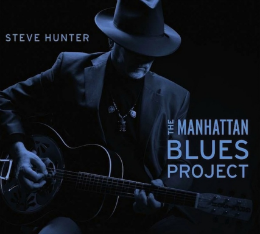 "The Manhattan Blues Project' album
"The Manhattan Blues Project' album
Since he and Karen married in 2007, Steve has put out four solo albums. “Hymns For Guitar” and “Short Stories” were both released in 2008. In 2013, he released “The Manhattan Blues Project” album and was supported by an all-star cast of guitarists including Joe Satriani, Joe Perry, and even Johnny Depp.
Hunter had met Depp at the 100 Club in London when the actor was working with Alice Cooper in the movie Dark Shadows. Alice invited Depp to come and jam with him and the band at the club. Depp came up to Steve and told him he was a big fan. When Steve started work on the “Manhattan Blues Project”, he got in touch with Depp and asked if he would like to play on a blues song called “Brooklyn Shuffle”.
Steve Hunter’s most recent release is 2014’s DVD and CD “Tone Poems Live”, a film of Hunter playing a career-spanning anthology in an intimate setting. It was shot on August 24, 2013 in a recording studio in Los Angeles with Tony Levin on bass, Phil Aaberg on keyboards, and Alvino Bennett on drums. The band rehearsed for two days and filmed on the third day as though it were in front of a live audience. The fourteen songs were chosen from Steve’s solo albums and feature not only his own compositions but also some of his classic covers including “Solsbury Hill”, “What’s Going On”, and Stevie Ray Vaughn’s “Riviera Paradise”.
If you go to Steve Hunter’s bio on his site, you will find this quote: “I don’t play for other guitar players. I play for women.” When asked about the quote he said this: “I don’t get up on stage to play guitar to impress guitar players. What I do care about, is whether the women out there like my playing. When I first started learning how to play blues, one of the things I figured out and one of the things I heard from B. B. King is that blues is feeling; it’s a feeling you have. He asked me one time, ‘Have you ever been hurt by a girl? I said, ‘Well sure’ B.B. then asked, ‘Do you remember what that felt like?’ After I replied ‘Yeah’, he said ‘Well you put that in your fingers when you play guitar’.” 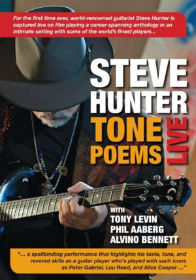
“If I’m up on stage and I’m going to be playing all night and doing solos, I try to envision a woman out in the audience that I’m going to seduce by my playing. It instantly puts a certain kind of sap into the playing. It’s just like acting. You can’t act like you’re mad; you have to be mad, to feel mad. Then you’re not acting anymore. It’s much the same when I’m playing guitar. If I was trying to seduce a girl by my playing then every note I play has meaning and it has feelings. Music for me doesn’t come from ego. It comes from your heart and sometimes from your crotch - it’s the sound that your feelings make.”
Steve Hunter was voted into the Michigan Rock and Roll online Hall of Fame in 2015. That same year, “Rock ’N Roll”, as recorded by Detroit with Mitch Ryder on vocals and Steve Hunter on lead guitar, was voted a Legendary Michigan Song.
MRRL Hall of Fame: https://www.michiganrockandrolllegends.com/mrrl-hall-of-fame
Video: Listen to Steve Hunter perform "Dust Storm" at: https://www.youtube.com/watch?v=HgE0BWHLBmk
